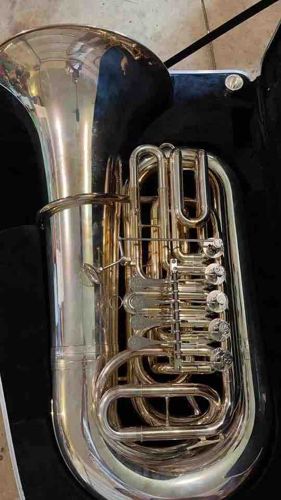
Tuba (Rotary Valve)
This is a large, brass wind instrument, specifically a tuba, designed for orchestral, concert, and band performances. The instrument appears to be constructed primarily of brass, likely lacquered or silver-plated, giving it a bright, reflective metallic finish. It features a conical bore that expands significantly into a large, prominent bell pointing upwards/forwards. The body of the tuba is characterized by its intricate system of tubing, bends, and valves. Visible are four rotary valves arranged in a row, each with a finger paddle, suggesting a 4-valve configuration, which is common for tubas for extended range and improved intonation. The connecting tubing, slides, and braces are clearly visible, showcasing the complex plumbing required for sound production. The instrument shows signs of wear consistent with use, including minor scratches, scuffs in the finish, and potentially some small dents or dings on the broader surfaces and tubing, though no major structural damage is immediately apparent. The reflective surface of the bell shows reflections of the surrounding environment, indicating a reasonably good polish, though some tarnishing or dulling might be present in less accessible areas. The overall craftsmanship appears to be of good quality, typical of a student or intermediate-level instrument, possibly from the late 20th or early 21st century given its contemporary valve design. There are no discernible maker's marks or signatures visible in the provided image.
AI-Generated Appraisal Disclaimer
Estimated Value
$800-1,500
Basic Information
Category
Musical Instrument
Appraised On
November 28, 2025
Estimated Value
$800-1,500
Item Description
This is a large, brass wind instrument, specifically a tuba, designed for orchestral, concert, and band performances. The instrument appears to be constructed primarily of brass, likely lacquered or silver-plated, giving it a bright, reflective metallic finish. It features a conical bore that expands significantly into a large, prominent bell pointing upwards/forwards. The body of the tuba is characterized by its intricate system of tubing, bends, and valves. Visible are four rotary valves arranged in a row, each with a finger paddle, suggesting a 4-valve configuration, which is common for tubas for extended range and improved intonation. The connecting tubing, slides, and braces are clearly visible, showcasing the complex plumbing required for sound production. The instrument shows signs of wear consistent with use, including minor scratches, scuffs in the finish, and potentially some small dents or dings on the broader surfaces and tubing, though no major structural damage is immediately apparent. The reflective surface of the bell shows reflections of the surrounding environment, indicating a reasonably good polish, though some tarnishing or dulling might be present in less accessible areas. The overall craftsmanship appears to be of good quality, typical of a student or intermediate-level instrument, possibly from the late 20th or early 21st century given its contemporary valve design. There are no discernible maker's marks or signatures visible in the provided image.
Related Tags
Get Your Items Appraised
Instant estimates of your treasures with AI-powered instant appraisals